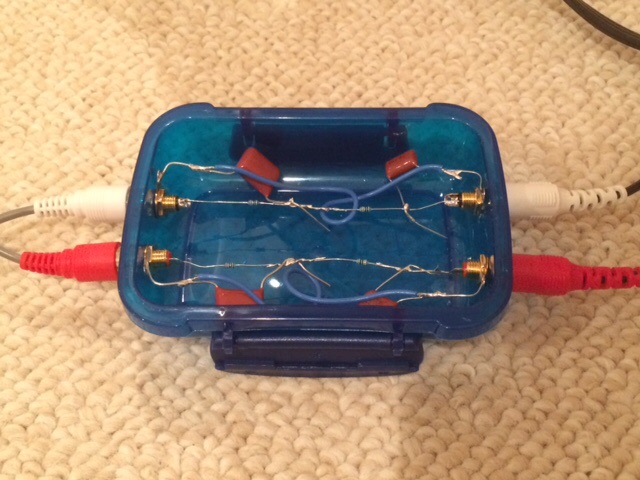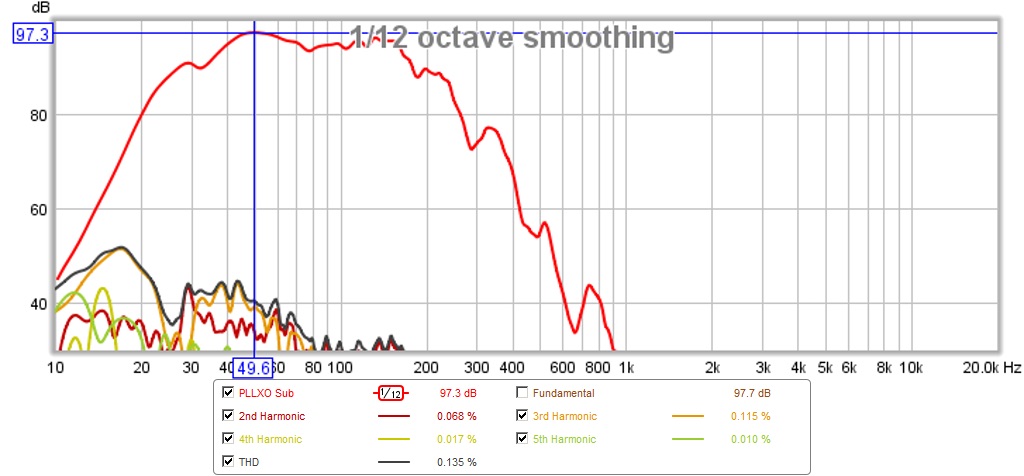I have a Kendood KA-894 sitting idly and would like to use it as a subwoofer amplifier. it sounds wonderful and has lots of power but my trusty T amp will be handling my TriTrix TL mains
I want some real low sound from a subwoofer to handle the <150 hz range.
I plan to run the amp in bridge parallel with a 1-2 ohm resistor in series with each output and the inputs mono so the output voltages are always matched(will verify this works first) all operating a 4 ohm subwoofer so that each channel sees a 9-10 ohm load.
subwoofer design I can handle but what for crossover?
budget for crossover is about $30 and I have plenty of soldering skill.
input impeadance of the amp is 47k ohm and output impeadance of the LLC I will build should be 1k ohm.
would the best option be a passive inductor-capacitor crossover ($25 ish) between the amp and sub or would a RC crossover or (more expensive) active crossover before the amp stage?
one last question: does the subwoofer's inductance make a second order crossover behave as third order and could I design the crossover as a third order but using the speaker inductance as the second inductor so I only have one inductor and capacitor?
I want some real low sound from a subwoofer to handle the <150 hz range.
I plan to run the amp in bridge parallel with a 1-2 ohm resistor in series with each output and the inputs mono so the output voltages are always matched(will verify this works first) all operating a 4 ohm subwoofer so that each channel sees a 9-10 ohm load.
subwoofer design I can handle but what for crossover?
budget for crossover is about $30 and I have plenty of soldering skill.
input impeadance of the amp is 47k ohm and output impeadance of the LLC I will build should be 1k ohm.
would the best option be a passive inductor-capacitor crossover ($25 ish) between the amp and sub or would a RC crossover or (more expensive) active crossover before the amp stage?
one last question: does the subwoofer's inductance make a second order crossover behave as third order and could I design the crossover as a third order but using the speaker inductance as the second inductor so I only have one inductor and capacitor?
Why would you want resistors in series with your speaker?
Do you have access to Conrad? They have an active 12db/oct LLC for 10 euros.
Do you have access to Conrad? They have an active 12db/oct LLC for 10 euros.
Hi,
Parallel (bridge parallel requires 4 channels) only requires
about 0.2 R is series with each output to nullify the offsets.
A passive RC should be OK, but its turnover point needs
needs to be really low to integrate with the TriTrix and
and boost the subs low bass. You can forget about any
sort of passive x/o in series with the sub, very bad idea,
as such things are impossible to get right first time.
You can use a tape loop to add another RC to the input.
rgds, sreten.
Parallel (bridge parallel requires 4 channels) only requires
about 0.2 R is series with each output to nullify the offsets.
A passive RC should be OK, but its turnover point needs
needs to be really low to integrate with the TriTrix and
and boost the subs low bass. You can forget about any
sort of passive x/o in series with the sub, very bad idea,
as such things are impossible to get right first time.
You can use a tape loop to add another RC to the input.
rgds, sreten.
at max volume on this amp the offset is around .3 volts. at 0.2 ohm resistors, that would be V^2/(2r) so 0.225 watts of "fighting" between the amps.Hi,
Parallel (bridge parallel requires 4 channels) only requires
about 0.2 R is series with each output to nullify the offsets.
A passive RC should be OK, but its turnover point needs
needs to be really low to integrate with the TriTrix and
and boost the subs low bass. You can forget about any
sort of passive x/o in series with the sub, very bad idea,
as such things are impossible to get right first time.
You can use a tape loop to add another RC to the input.
rgds, sreten.
this amplifier has an "adapter out/in" stage that stock has shorting pins installed. theoretically I could simply do a 2nd order RC circuit there and that would be really cheap to test with radioshack caps and then I'll replace with some good audio grade caps later.
that design has a lot of parts, and without pictures I struggle to make sense of it.
Why would you want resistors in series with your speaker?
Do you have access to Conrad? They have an active 12db/oct LLC for 10 euros.
the resistors are to keep the amp from fighting with itself when both channels will be driving the same load
Probably this page will help: ESP Projects Pages - DIY Audio and Electronics
A lot of explanations and simple topologies...
A lot of explanations and simple topologies...
Use passive line level XO (PLLXO)
If you put a couple of resistors and caps together ($2 max) between your source line level and amp input, you can get a -12dB/oct low pass for your sub. I just built almost exactly what you need last night and am listening to it now. It works beautifully.
Basically you need to know your amplifier input impedance, and yours is 47kohm. Same as mine so you can just take my circuit as I designed to Cross at about 150Hz.
I used a 0.16uF and 0.016uF metal film caps and a 10k and 100k resistor in a $0.50 box from the dollar store and four RCA jacks. You could skip the jacks and take an existing RCA cable and cut in half and wire directly.
More info on schematic and design here:
TLS.org | Passive Line-Level Crossover
Give it a try and you will be pleasantly surprised how well it works. No big expensive passive coils needed.
Here is a photo:

If you put a couple of resistors and caps together ($2 max) between your source line level and amp input, you can get a -12dB/oct low pass for your sub. I just built almost exactly what you need last night and am listening to it now. It works beautifully.
Basically you need to know your amplifier input impedance, and yours is 47kohm. Same as mine so you can just take my circuit as I designed to Cross at about 150Hz.
I used a 0.16uF and 0.016uF metal film caps and a 10k and 100k resistor in a $0.50 box from the dollar store and four RCA jacks. You could skip the jacks and take an existing RCA cable and cut in half and wire directly.
More info on schematic and design here:
TLS.org | Passive Line-Level Crossover
Give it a try and you will be pleasantly surprised how well it works. No big expensive passive coils needed.
Here is a photo:

Attachments
Last edited:
If you put a couple of resistors and caps together ($2 max) between your source line level and amp input, you can get a -12dB/oct low pass for your sub. I just built almost exactly what you need last night and am listening to it now. It works beautifully.
Basically you need to know your amplifier input impedance, and yours is 47kohm. Same as mine so you can just take my circuit as I designed to Cross at about 150Hz.
I used a 0.16uF and 0.016uF metal film caps and a 10k and 100k resistor in a $0.50 box from the dollar store and four RCA jacks. You could skip the jacks and take an existing RCA cable and cut in half and wire directly.
More info on schematic and design here:
TLS.org | Passive Line-Level Crossover
Give it a try and you will be pleasantly surprised how well it works. No big expensive passive coils needed.
Here is a photo:

this is exactly what I was looking for. I had a feeling this would be the design of choice but wasn't sure how good it would sound. metal film caps should be easy enough to come by. what type of resistor would you recommend? I was thinking that standard carbon film resistors would do fine, and I already have every 5% carbon resistor from 1 ohm to 4M ohm.
Carbon film is fine and ceramic caps are fine too if you can get them. If you have SMT parts you can make this thing fit on a dime for $1 in parts. Glue SMT onto paper with PVA glue and solder point to point.
If you want to hear what it sounds like check out sound clips here:
http://www.diyaudio.com/forums/full-range/223313-foam-core-board-speaker-enclosures-252.html#post4135528
If you want to hear what it sounds like check out sound clips here:
http://www.diyaudio.com/forums/full-range/223313-foam-core-board-speaker-enclosures-252.html#post4135528
Here is the reaponse of my sub as measured at the mouth with this PLLXO.

if you say it sounds good to your ear, then that's what I'll go with. looks like I'm keeping the total cost of my subwoofer under $100 for a 200W 15'' which makes me very happy.
probably gonna go large low tuned ported or large sealed.
I might end up crossing over considerably lower depeding on where I think my tritrix starts to need help. they should be done building within a week. luckily this style crossover is insanely cheap to implement at most any frequency. thanks!
Since it is so cheap, buy several sets of caps and resistors at 50Hz, 80Hz, 100Hz etc. Test it out to see what sounds good. I actually designed this with a 100Hz XO freq but in practice it turned out to be closer to 200Hz. I even measured my amps input inpendance. So anyhow, keep that in mind.
- Status
- Not open for further replies.
- Home
- Loudspeakers
- Subwoofers
- sub crossover design on a college budget. help please.


